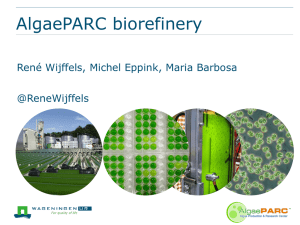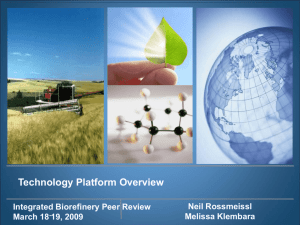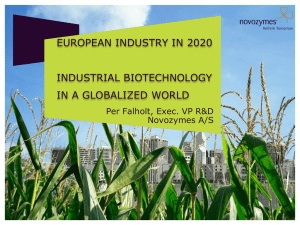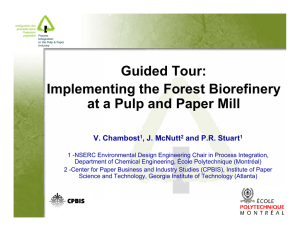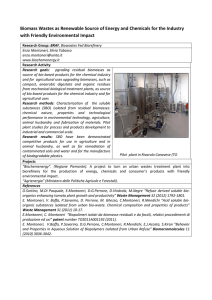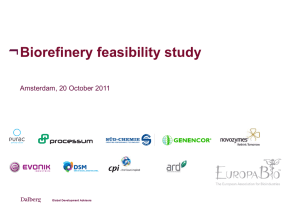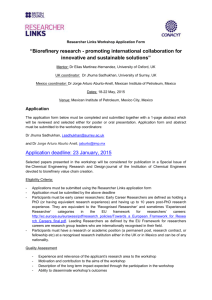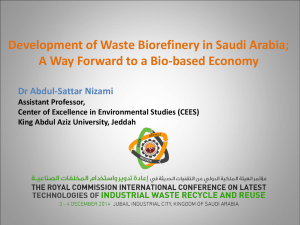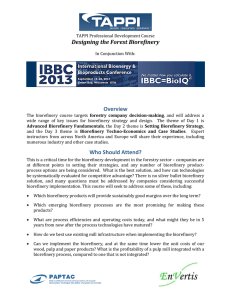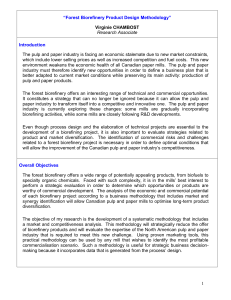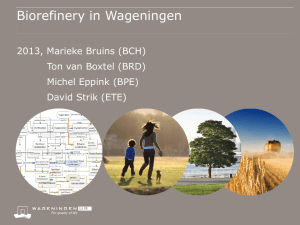The Role of Biorefinery Partnership Strategies: North American Perspective
advertisement
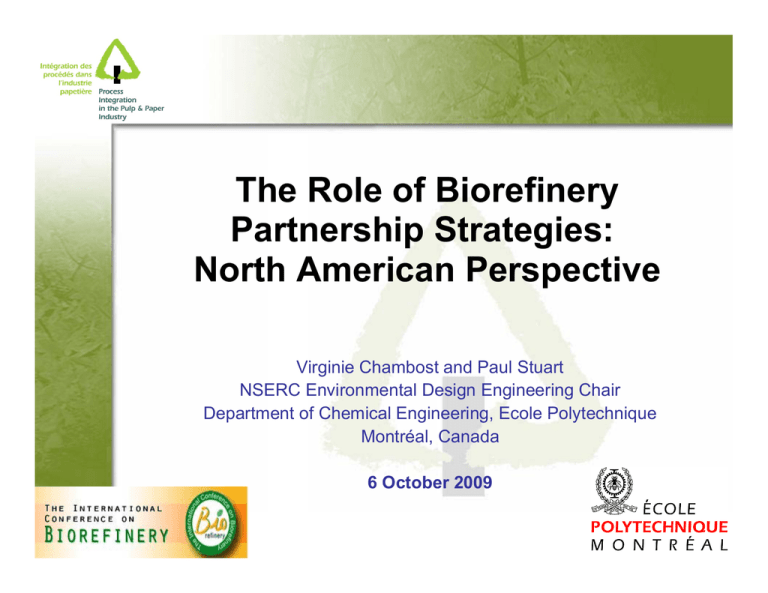
The Role of Biorefinery Partnership Strategies: North American Perspective Virginie Chambost and Paul Stuart NSERC Environmental Design Engineering Chair Department of Chemical Engineering, Ecole Polytechnique Montréal, Canada 6 October 2009 Objective of this Presentation To raise some critical issues that might be considered by forestry companies seeking to identify promising biorefinery product and process pathways ...based on the definition of ‘quality’ partnerships and sustainable business model Presentation Outline Collaboration is Essential for Growing Businesses Successfully The Role of Partnership for Forest Biorefinery Implementation The North American and European State-ofthe-Art A Market-driven Strategy for Identifying the Most Promising Product-Partner-Process Combinations Points of Departure Either as part of the modification of an existing business model or the definition of a new business model, New Product Development is supported by: An Innovation Roadmap in order to strategically identify the right product/market combination. A Deployment Strategy for ensuring market penetration and value creation via (a) partners identification and (b) alliance structure definition Good collaborations are based on distinctive competencies and shared objectives and should be driven by a two-way win-win business model Ben Thorp, Masood Akhtar, ‘Innovation without Proper Deployment is a Waste’, Paper 360, 2007 Raising the Odds of Success With Strategic Alliances Cost-driven alliances between companies are evolving to knowledge-intensive alliances… Establishing new assets and new capabilities Maximum opportunity for capturing value from leveraging existing assets Secure new incremental revenues Elaboration of existing capabilities and incremental improvement in efficiencies Mitchell Koza, Arie Lewin, ‘Managing Partnerships and Strategic Alliances’, European Management journal, 2000 Building Strategic Alliances Hybrid alliances ensure the creation of competitive advantages that will support margins improvement and value capture – not simply provision of lowcost commodity products Define alliance feasibility and shape the structure for exploiting alliance potential Define common business visions and work towards risk minimization Marc Douma, et al., ‘Strategic Alliances ~ Managing the Dynamics of fit’, 2000 Presentation Outline Collaboration is Essential for Growing Businesses Successfully The Role of Partnership for Forest Biorefinery Implementation The North American and European State-ofthe-Art A Market-driven Strategy for Identifying the Most Promising Product-Partner-Process Combinations Identifying the Right Biorefinery... Which combination is best? Exploiting Mature Value Chains Janssen, Chambost, ‘Successful Partnerships for the Forest Biorefinery’, 2008 Product identification first ~ Process issues second Product diversification towards a changed product portfolio implies the penetration of non-traditional markets where demand already exists and is already met. Existing value chains should be an important part of the forest biorefinery product thinking ~ out-of-the-box thinking. Short term competitive advantage Limited financial capacity Need for being first-to-market Economies of scale Secure low-cost for products Unique portfolio and SC Define type of partnership Key Partnership Elements The goal of a partnership for the FBR should be to Mitigate risk • Address competitive disadvantages of the partners Create competitive advantages The partnership must meet the corporate needs of each partner, and should be flexible There are many product portfolio opportunities, but few quality partnership opportunities Associated with the partners, few profitable and sustainable business scenarios are possible Presentation Outline Collaboration is Essential for Growing Businesses Successfully The Role of Partnership for Forest Biorefinery Implementation The North American and European State-ofthe-Art A Market-driven Strategy for Identifying the Most Promising Product-Partner-Process Combinations Examples of The North America Biorefinery Landscape DOE funded development ~ in collaboration with TRI ~ Pilots in place in SRI NC: Flambeau River Biofuels LLC (Park Falls) • Capacity of 9 million gallons per year of Fisher-Tropsch (F-T) green diesel • 50 million pounds of Fisher-Tropsch wax • DOE will provide up to $30 million NewPage Corporation (Wisconsin Rapids) • Thermal gasification and gas-to-liquids plant at their Wisconsin Rapids Mill to replace natural gas use and produce liquid biofuels, specifically renewable diesel • Capacity of 5.5 million gallons per year of Fisher-Tropsch (F-T) fuels • DOE will provide up to $30 million Examples of the North America Biorefinery Landscape DOE Funded Redshield ~ Old Town, Maine • Pre-pulping extraction technology • Capacity of 2.2 million gallons per year of cellulosic ethanol from 80 tons per day via wood extract • DOE will provide up to $30 million Verenium ~ Jennings 1.4 million gallon-per-year (MGY) cellulosic ethanol plant Demonstration-scale plant capable of producing ethanol from non-food cellulosic biomass sources Other Important Collaborations in NA Coastal Paper (Wiggins, Mississippi) signed a 15year energy supply agreement with Intrinergy, a renewable energy company for industrial customers, to implement a biomass gasifier. UOP/Ensyn ~ Envergent Weyerhaeuser: With Chevron ~ Catchlight Energy With Lignol ~ Explore commercial applications of products from Lignol process With Lenzing ~ Launch pilot plant for novel TencelWeb™ nonwoven fabrics Weyerhaeuser – Chevron Catchlight Energy Biochemical and thermochemical conversion to transportation liquids Value Chain Creation… Some Conclusions and Comparisons North American companies have begun to embark in the forest biorefinery. Only a few concrete strategies for commercial biorefinery partnerships have been announced to date. What is happening in Europe? Chemrec at Pitea and Domsjö Stora Enso and Neste Oil ~ NSE Biofuel Oy JV UPM-Kymmene and Andritz/Carbona Norske Skog and Choren: Xynergo Subsidiary Chemrec Success Story ~ Building a New Value Chain... Gasification Pilot Plant in Piteå at Smurfit Kappa mill: Production of renewable automotive fuel called BioDME Start-up forJuly 2010 with a capacity of about 4 tons (1,600 gallons) per day using forest residues as feedstock Consortium members: Chemrec, Haldor Topsøe, Volvo, Preem, TOTAL … Estimated cost of the plant is SEK 150 million (EUR 14 million, USD 20 million) Commercial Scale with Domsjö Fabriker: Announced project cost about SEK 2,800 million (US$360 million) and is expected to start-up in late 2012 The plant would produce about 40 million gal/a of second generation renewable automotive fuels biodimethylether and biomethanol, produced from gasified black liquor Characterizing Emerging Biorefinery Partnerships Conclusions and Observations European forestry companies have established varied and substantive collaborations for the biorefinery, each for a specific business context It will be interesting to watch them evolve North American companies should target (1) the identification of unique new business models, and (2) the definition of their step-by-step approach for embarking in concrete biorefinery developments in order to mitigate risks Presentation Outline Collaboration is Essential for Growing Businesses Successfully The Role of Partnership for Forest Biorefinery Implementation The North American and European State-ofthe-Art A Market-driven Strategy for Identifying the Most Promising Product-Partner-Process Combinations Products, Product Families, and Product Portfolios Waste Chips Biomass Pulp and Paper Mill Co-products or wastes? Yield? Building Block Yield? Yield? Intermediate Specialty or fine chemicals New Product Family P&P Products $$ Main Biorefinery Products to Market $$$$ New Product Portfolio Reducing Volumes, Flexible Throughputs… Increasing Process Complexity Benefiting from Existing Value Chains When looking at implementing the biorefinery, a ‘local’ approach is essential for the feedstock supply, and ‘regional’ for the customer What is the potential of (1) entering a local and mature value chain, (2) creating value while improving margins, and (3) capturing value via a strategic partnership? e.g., existing infrastructure e.g., existing and new competition Potential commercial partners Market-Driven Approach for Product Family Identification Phase 1: Point of Entry - Value chain approach - Partnership evaluation - Technological viability Objective: Identify possible points of entry and associated partners for biorefinery ideas Phase 2: Product Family JV -Preliminary strategic discussion with potential partner(s) - Product family expansion in the potential JV Objective: Develop business plans involving product families built around the point of entry strategies Unique Partnerships Provide Competitive Advantages Local Feed supply Taking advantage of local SC and market penetration JV with a chemical company interested in producing Bio-PE Flexibility in selling quantities of ethanol, ethylene and PE ~ 3 markets are achievable and have distinct characteristics... Integrated and flexible supply chain Control of the margins across the value chain through margins-based SC Integration of the mill into the JV? Opportunity to decrease production of traditional pulp and paper products while increasing margins from value-added products sales Provides opportunity for unique and flexible product portfolio The definition of the JV structure should support the interests of each partner and unleash value Final Messages Each forestry company has unique existing assets including facilities, access to biomass, etc, and should seek to identify their biorefinery strategy: Partner selection and partnership model are critical in order to create competitive advantage A value chain approach from feedstock supply to endmarket distribution is essential in order to mitigate risks related to, for example, market penetration and exploiting mature supply chains. Existing value chains will be impacted ~ it is essential to take a ‘Think global, Act local’ approach. Thank you!
